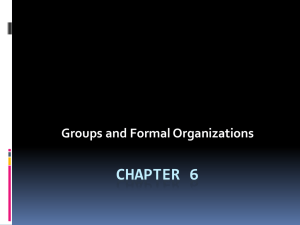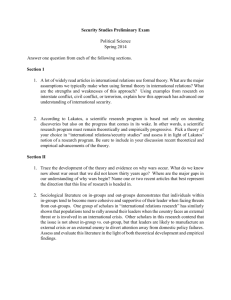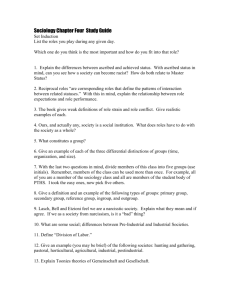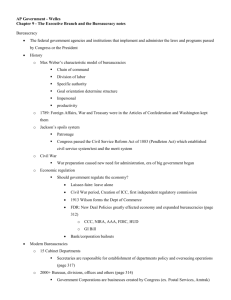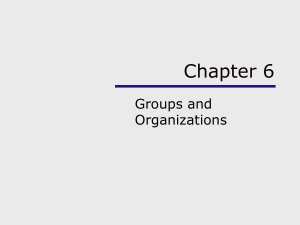Sociology Chapter 7 Powerpoint
advertisement
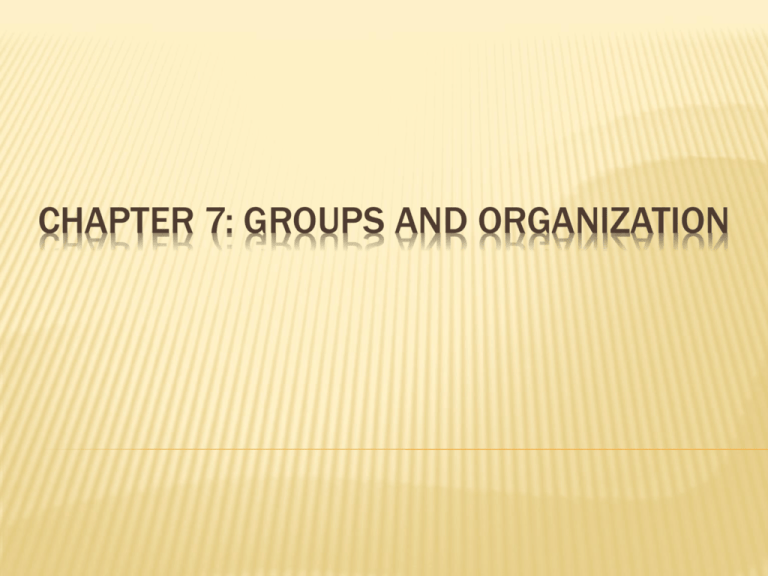
CHAPTER 7: GROUPS AND ORGANIZATION SECTION 1: INTRODUCTION TO GROUPS AND ORGANIZATION Groups are prevalent in our social lives and provide a significant way we understand and define ourselves Help foster social value systems and are key to the structure of society 3 sociological perspectives are used to primarily study groups: Functionalist, Conflict and Symbolic Interaction (Interactionist) CONTINUE INTRODUCTION TO GROUPS AND ORGANIZATION Functionalist Perspective Big picture, macro-level view looking at how all the different aspects of society are intertwined Idea that society is a well-balanced system with all parts necessary for the whole Studies how the roles play a part in relation to the whole Conflict Perspective Big picture, macro-level view on the genesis and growth of inequality CONTINUE INTRODUCTION TO GROUPS AND ORGANIZATION Symbolic Interaction (Interactionist) Little picture, micro-level view of the day to day interactions of groups Examples like leadership style and group dynamics SECTION 2.1: TYPES OF GROUPS Defining a group Group – amorphous (without clear shape or form) can refer to a wide variety of gatherings; a collection of at least 2 people who interact with some frequency and who share a sense that their identity is aligned with the group Not every time people are gathered is that group Aggregrate (crowd) – people who exist in the same place at the same time, but who don’t interact or share a sense of identity Category – people who share similar characteristics but are not tied to one another in any way CONTINUE TYPES OF GROUPS They may share a sense of identity but don’t, as a whole, interact frequently with each other People in aggregates and categories can become a group Also, there can be many groups within a single category Category – Teachers Groups – Union members, non-union members, teachers who coach, teachers involved with the PTA SECTION 2.2 TYPES OF GROUPS Groups are primarily broken down into 2 categories: primary groups and secondary groups Primary groups – usually fairly small and made up of individuals who engage face-to-face in long-term emotional ways (family members); expressive functions rather than pragmatic functions Secondary groups – often larger and impersonal, task focused and time-limited (classmates or office workers); serves an instrumental function rather than expressive Neither are bound by strict definitions or set limits CONTINUE TYPES OF GROUPS People can move from one group to another SECTION 2.3: IN-GROUPS AND OUT-GROUPS Groups can gain power and stay in power through inclusion and exclusion In-groups and out-groups are subcategories of primary and secondary groups In-group – the group that an individual feels they belong to and believes is an integral part of who they are Out-group – a group someone doesn’t belong to, an there may be a feeling of disdain or competition in relation to an out-group CONTINUE IN-GROUPS AND OUT-GROUPS Examples of in-groups or out-groups: Sports teams, fraternities, sororities, unions Affiliations can be neutral or positive Can also help explain some negative human behavior When others are defined as “not like us”, ingroups can end up practicing: ethnocentrism, racism, sexism, ageism, heterosexism Judging others negatively based upon their culture, race, sex, age or sexuality CONTINUE IN-GROUPS AND OUT-GROUPS In-groups can also form inside of secondary groups These in-groups can band together to show favoritism or affinity for others within the group while the overall organization may be unwilling or unable to acknowledge it The politics of the in-group can be used to exclude others from gaining status within the group CONTINUE IN-GROUPS AND OUT-GROUPS Reference groups – a group that people compare themselves to, used as a standard of measurement Examples: peer groups; many pay attention to the style of dress, music, attitudes and compare themselves to what they see There can be more than one reference group Other examples: churches/synagogues/mosques, workplace, family gathering, parents Many can also have competing messages We use these groups to help guide behavior and show social norms CONTINUE IN-GROUPS AND OUT-GROUPS Reference groups can impact and influence how we act even if you’ve never met or know one Can help us understand the social identities we aspire to or want to distance ourselves from Reference groups can become our in-group or outgroup Can define our friends and our enemies SECTION 3.1: GROUP SIZE AND STRUCTURE Small groups are typically defined as one where all the members of the group know each other and share simultaneous interaction Can be divided into two categories: Dyads – a 2 member group If one member leaves, the group no longer exists: divorce or 2 best friends never speaking again Triads – a 3 member group The group can survive if one person leaves 2 v. 1 dynamics can develop leading to the potential for a majority opinion on an issue CONTINUE GROUP SIZE AND STRUCTURE Small groups tend to have strong internal cohesiveness and a sense of connection Hard to achieve large goals; struggle to be heard or to be a force of change; easy to be ignored Hard to determine when a small group becomes a large group Too many people to join in simultaneous discussion Joining with other groups as part of a movement that unites them CONTINUE GROUP SIZE AND STRUCTURE Larger groups may share geographic space or be spread across the globe The larger the group, the more attention it can garner and the more pressure they can exert toward the goal they wish to achieve The downside is, the larger the group becomes, the more susceptible it is to division and lack of cohesion SECTION 3.2: GROUP LEADERSHIP Large groups require some type of leadership Leadership in small groups tends to be informal Primary groups tend not to have formal leadership Secondary groups can have overt leaders with outline roles and responsibilities with a chain of command to follow; think of the Army Styles and functions of leadership can vary considerably CONTINUE GROUP LEADERSHIP • Leadership function – the main focus or goal of the leader • • Instrumental leader – one who is goal oriented and concerned with accomplishing set tasks (CEOs and generals), stereotypically men Expressive leader – more concerned with promoting emotional strength and health, that people are supported (social and religious leaders), stereotypically women • • Gender roles have changed, breaking stereotypes Both men and women prefer leaders who use a combination of expressive and instrumental leadership CONTINUE GROUP LEADERSHIP Leadership Styles Democratic Leader– encourage group participation in all decision making Common in clubs where members vote on activities or projects Leaders can be well liked but a challenge in dealing with work due to the time consuming consensus building Also can lead into group members picking sides and turning into opposing factions rather than reaching solutions CONTINUE GROUP LEADERSHIP Laissez-faire leader – a hands-off leader, allowing group members to self-manage and make their own decisions Can work well with highly motivated and mature participants who have clear goals and guidelines Risks group dissolution and lack of progress In French it means “leave it alone” CONTINUE GROUP LEADERSHIP Authoritarian leader – issue orders and assigns tasks Clear instrumental leaders with a strong focus on meeting goals Entrepreneurs are a good example of this type of leader Risks alienating members of the group Certain times require this type of leadership In different circumstances, all these leadership styles can be effective and successful. SECTION 3.3: CONFORMITY Conformity – the extent to which an individual complies with group norms and expectations Everyone wants to fit in to some degree We use reference groups to assess and understand how to act, to dress and to behave; we are aware of who conforms and who does not Will we conform with indifference to our own morals and intelligence? Peer pressure Knowing the difference between right and wrong CONTINUE CONFORMITY Solomon Asch Experiments illustrated how great the pressure was to conform, especially within a small group Read through the experiment on page 201 Would you have conformed? Would you have spoken up? What variables keep people from speaking up or for speaking out Philip Zimbardo Stanford Prison Experiment https://www.schooltube.com/video/237e7769aa970 bcec446/ SECTION 4: FORMAL ORGANIZATIONS A big complaint of modern life is that society is dominated by formal organizations - large, impersonal secondary organizations Schools, businesses, healthcare, government Almost all of these are, or will become a bureaucracies – an ideal type of formal organization characterized by a collection of characteristics, or a type that could describe most examples of an item under discussion Also, the administrative system governing any large institution CONTINUE FORMAL ORGANIZATIONS Has developed negative connotations such as inefficiency, complexity and inflexibility SECTION 4.1: TYPES OF FORMAL ORGANIZATIONS Formal organizations fall into 3 categories: Normative organizations (voluntary organizations) – based on shared interests; joining is voluntary and done due to people finding membership being an intangible reward Ski Club, Boy Scouts Coercive organizations – groups that people are coerced or pushed to join Prison, rehab Total institutions – institutions in which inmates live a controlled lifestyle and where total resocialization takes place CONTINUE TYPES OF FORMAL ORGANIZATIONS Utilitarian organizations – joined because of the need for a specific material reward High school (diploma) or work (money) Table of Formal Organizations Normative or Voluntary Coercive Utilitarian Benefit of Membership Intangible Benefit Corrective Benefit Tangible Benefit Type of Membership Volunteer Basis Required Contractual Basis Feeling of Connectedness Shared Affinity No Affinity Some Affinity SECTION 4.1.1: BUREAUCRACIES Bureaucracies An ideal type of formal organization A hierarchy of authority with a clear division of labor, explicit rules and impersonality People see them as slow, rule-bound, difficult to navigate and unfriendly Hierarchy of authority – one individual or office is in charge of another, who in turn has to answer to their superiors Chain of command CONTINUE BUREAUCRACIES Clear division of labor – each individual has a specialized task to perform Explicit rules – ways rules are outlined, written down and standardized No crossover work or cooperation between people Rules have to also change as time passes Impersonality – takes personal feelings out of professional situations Protects organizations from nepotism, backroom deals, and favoritism; these protect customers and others served by the organization An attempt to protect it’s members CONTINUE BUREAUCRACIES Meritocracies – hiring and promotion within bureaucracies are based upon proven and documented skills rather than nepotism or random choice This is the theory at least Getting into prestigious colleges – high SATs and impressive transcripts Becoming a lawyer – graduating from law school (getting in requires a GPA and passing the LSATs) and passing the state bar exam There are always exceptions to the rule CONTINUE BUREAUCRACIES Positive aspects of bureaucracies (when it works) Improve efficiency Ensure equal opportunities Increase efficiency Some have rigid hierarchies Specific time periods and situations need them Negative aspects of bureaucracies (when it doesn’t) Inflexible Too much adherence to explicit rules and division of labor can leave an organization behind Hard to change the direction of an organization when a bureaucracy has been in place for so long Can be stuck in the past CONTINUE BUREAUCRACIES • Iron Rule of Oligarchy – an entire organization is ruled by a few elites • Suggestion about all large organizations SECTION 4.2: THE MCDONALDIZATION OF SOCIETY McDonaldization of Society – refers to the increasing presence of the fast food business model in common social institutions Business model includes efficiency (division of labor), predictability, calculability and control (monitoring) Example in a grocery store Efficiency – specific people at registers, deli counter and stocking shelves Predictability – same goods, same organization and same prices across the entire chain Calculability – goods are sold by the pound taking out guess work; workers use timecards to calculate hours and be paid CONTINUE THE MCDONALDIZATION OF SOCIETY • • • Control – employees wear a uniform and name tag; there are security cameras monitoring the store; specific areas of the store are off-limits to customers (stockroom) Has resulted in increased profits and increased availability of goods and services to people worldwide But, it’s also reduced the variety of goods available in the marketplace while making products uniform, generic and bland • • • Mass produced clothes vs. custom made Chicken from a farmer vs. chicken from a corporate farm Coffee from a local diner vs. coffee from Starbucks OTHER TOPICS IN SOCIOLOGY CONCERNING GROUPS • Deindividuation • Deindividuation refers to the phenomenon of relinquishing one's sense of identity, self-awareness, or evaluation apprehension • • • Can happen as a result of becoming part of a group that fosters obedience to group norms rather than an individual's norms Individuals no longer think about themselves before they act and may, in fact, be unaware of their own actions. Examples: the military or in a riot situation CONTINUE OTHER TOPICS IN SOCIOLOGY CONCERNING GROUPS • Diffusion of Responsibility • Diffusion of responsibility or the bystander effect is a social phenomenon which tends to occur in groups of people above a certain critical size when responsibility is not explicitly assigned. • • • Observing an action (crime, bullying, etc) and not doing anything because the assumption is that someone else will do so. This phenomenon rarely ever occurs in small groups. Examples: The murder of Kitty Genovese, the abduction of James Bulger, the murder of Nick Markowitz CONTINUE OTHER TOPICS IN SOCIOLOGY CONCERNING GROUPS • Groupthink • Groupthink describes a process by which a group can make bad or irrational decisions • • • Each member of the group attempts to conform his or her opinions to what they believe to be the consensus of the group This seems to be a very rationalistic way to approach the situation. However this results in a situation in which the group ultimately agrees upon an action which each member might individually consider to be unwise Examples: The Bay of Pigs Invasion, Pearl Harbor, 9/11, Iraq’s weapons of mass destruction capabilities and procurement of nuclear materials CONTINUE OTHER TOPICS IN SOCIOLOGY CONCERNING GROUPS • Social Networks • We are becoming more and more connected with the rest of the world through social networks (facebook and twitter for example) • • • The average separation of between 3 and 5 users up to the upper limit of around 12. Six Degrees of Separation Six Degrees of Kevin Bacon
